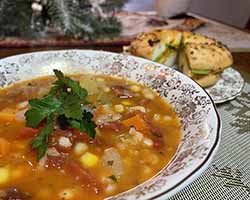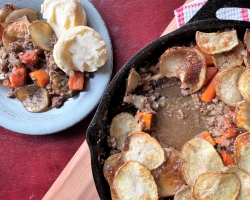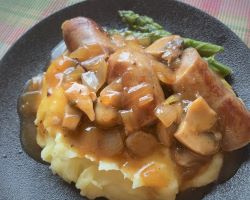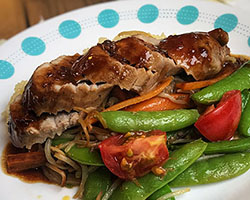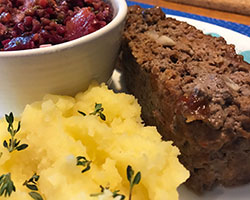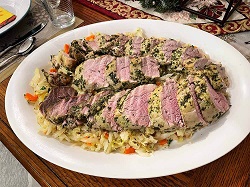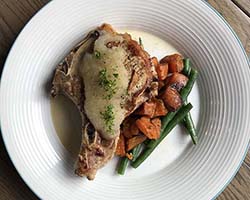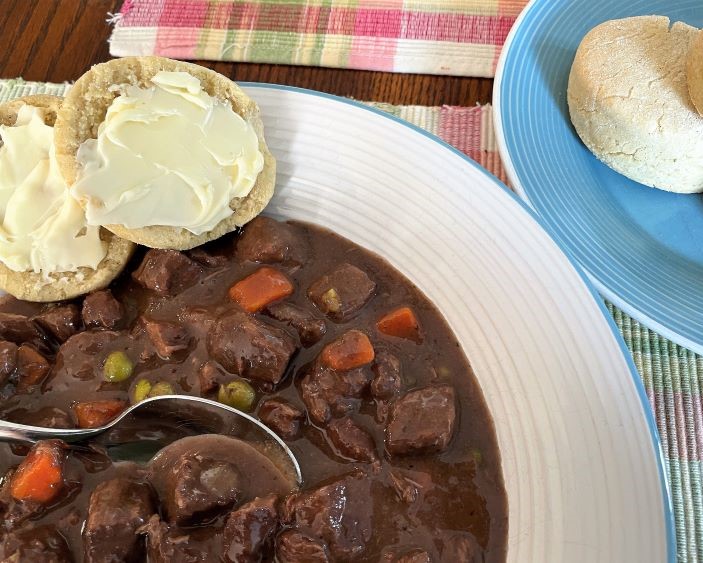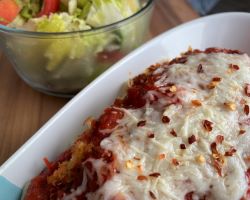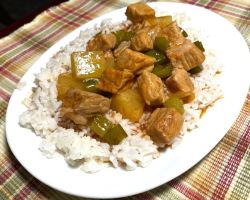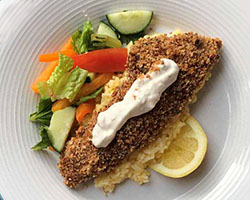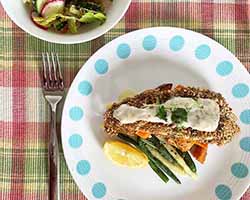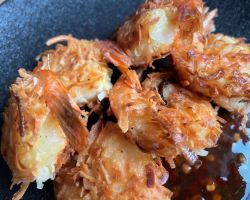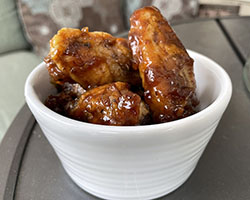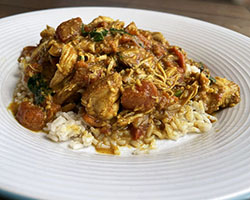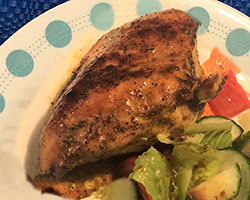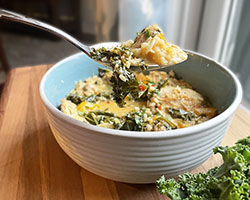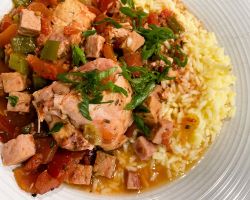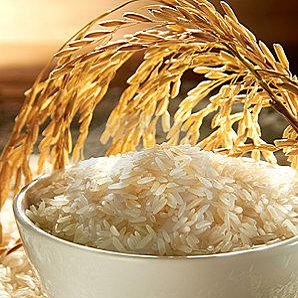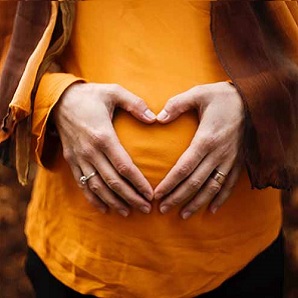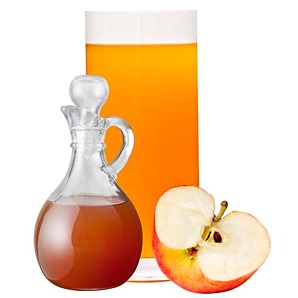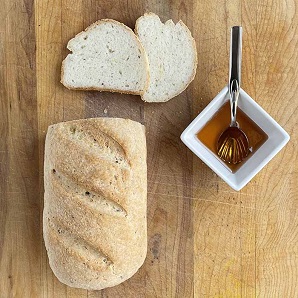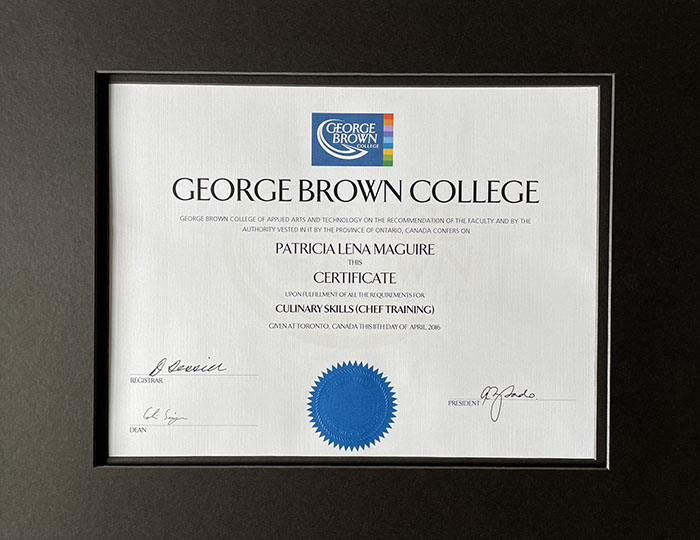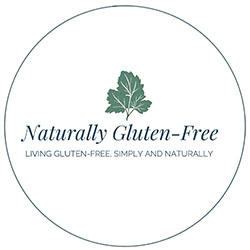- Home
- Gluten Free Cooking
- Meat Cooking
Gluten-Free Meat Cooking
By the time you finish reading this article you’ll know how to cook any piece of meat to tender, juicy, melt in your mouth perfection every time. You won’t even need a recipe!
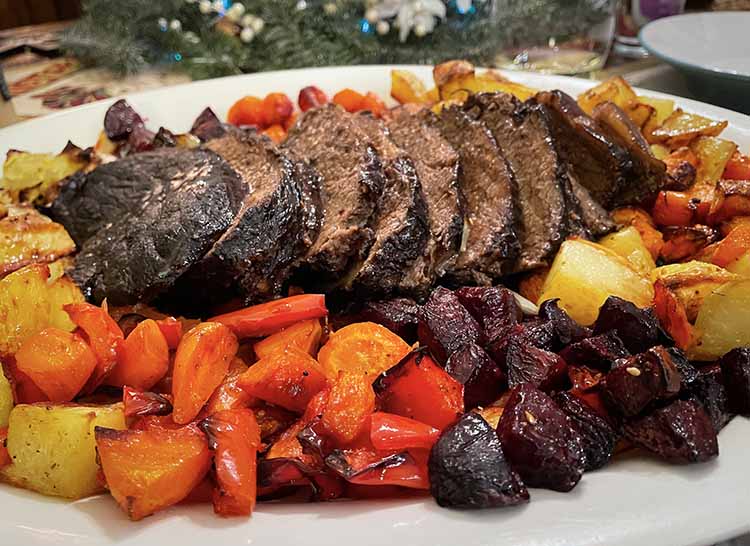 Gluten-Free Beef Pot Roast
Gluten-Free Beef Pot RoastWhat Makes a Meat Dish Gluten-Free?
It’s all about the ingredients and the environment.
All whole fresh cuts of meat are naturally gluten-free. It’s the ingredients you add as fillers, seasonings, marinades, coatings, and thickeners for sauces that you need to pay special attention to.
The surfaces you prepare your meat on as well as the grills, pans, and utensils must be clean so that you don’t introduce gluten cross contamination.
Here are some resources on buying gluten-free meat, making and buying sauces and how to substitute other ingredients to ensure your meat dish is gluten-free.
Everything you need to know about gluten-free meat cooking is all on one page for your convenience.
You can scroll through or jump to the section that interests you.
Dry Heat and
Moist Heat
Now that we have the gluten part out of the way, let’s break down the methods for cooking your gluten-free meat.
There are two types of heat for cooking. Dry heat and moist heat.
Dry heat cooking is done without liquid and with or without adding fat. Example of dry heat cooking methods are:
- roasting or baking
- pan frying
- stir frying
- grilling or broiling
- deep frying
Moist heat cooking is done with a liquid like water, stock, milk, juice, or wine. Examples of moist heat cooking methods are:
- boiling
- poaching
- steaming
If you combine dry and moist heat methods, it’s called braising.
Choosing the Right Cut of Meat
For a dish that is tender, moist, and full of flavor, it’s essential to choose the right cut of meat to match your cooking method. The wrong cut will have you chewing for days on dry tough hunks of fiber, and no one wants that.
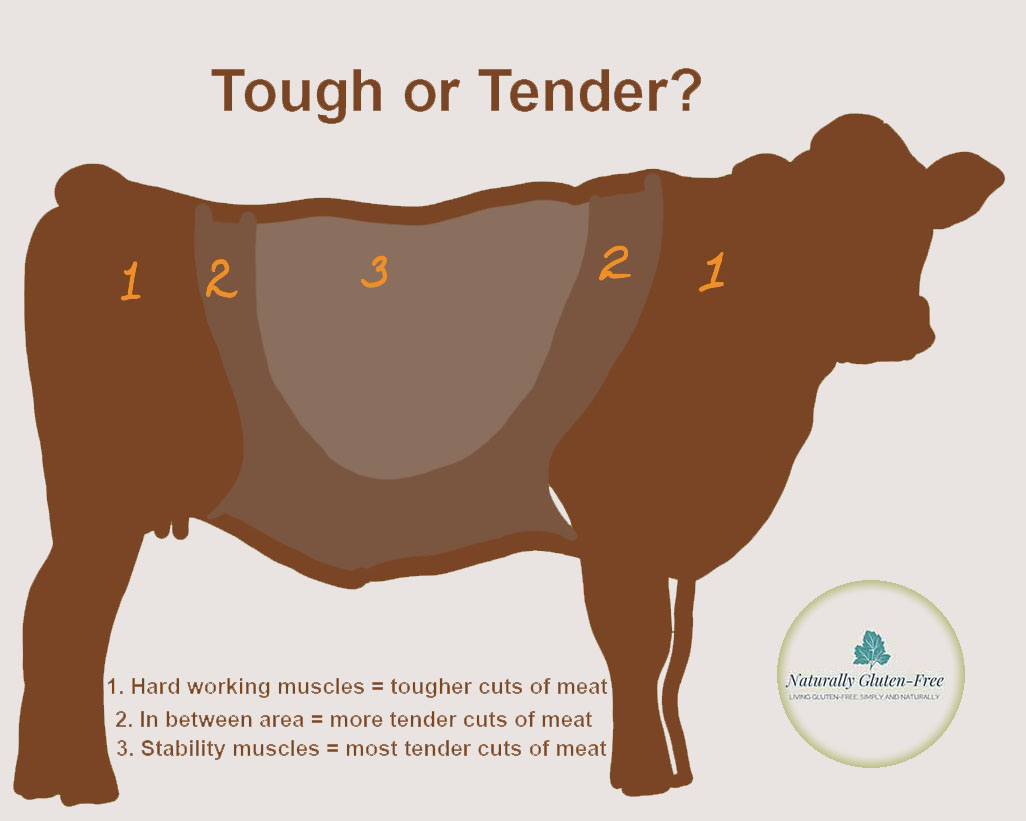
Dry heat cooking is done quickly at high temperatures, so there is no time to break down tough fibers. Look for the more tender cuts that come from parts of the animal that don’t work very hard. These are often the more expensive cuts. Examples are:
- sirloin steaks
- pork loin roast
- prime rib roast
- tender young chickens and turkeys
- all types of fish
Moist heat cooking and braising are done at lower temperatures and take more time, so you can choose the cheaper, tougher cuts of meat. They come from the parts of the animal that do the work and therefore have lots of fibrous collagen that takes time to break down. These are often the most flavorful cuts. That’s why a stew or a pot roast that simmers for hours has such a silky texture and deep robust flavor. Cuts you’re looking for are:
- rump roast or chuck
- brisket
- stewing beef
- pork or lamb shoulder
- lamb shanks
- ribs
- dark meat poultry like chicken thighs
Dry Heat
Cooking for Meat
There are two advantages of dry heat cooking. It’s quick and it browns the meat.
The browning
process is called the “Maillard reaction” and is the key to building deep
flavor and aroma in your meat dishes. It
also elevates the appearance. Think of a
beautifully browned steak with lovely grill marks. Now think of what that steak would look like
if it were boiled instead. Kind of grey
and unappealing right?
back to top
Temperature Control is Essential
High heat is key to browning, but not too high. You don’t want to burn that expensive cut of meat!
The Maillard reaction gets nicely started at about 300°F, but if the surface temperature of the meat gets much over 355° then it will start to burn, creating a blackened surface and bitter taste1.
You’ll notice most recipes for roasting tell you to set your oven at a high temperature, usually 350° to 375°. For grilling or pan frying the directions will say to use “medium-high heat”. Always keep an eye and be ready to adjust the temperature down if your meat starts to burn, or up if it’s not browning.
Moisture is
the Enemy of Browning
For any of the dry heat methods make sure your meat is dry. Moisture on the surface will create steam and prevent it from reaching the temperature necessary for browning.
Pat it Dry
Pat your meat with a paper towel then brush it with oil and add your seasoning. If you’ve used an oil based marinate then drying won’t be necessary, but if your meat has been sitting in a liquid like wine, stock or salt water you’ll need to dry it off.
Don't Crowd the Pan
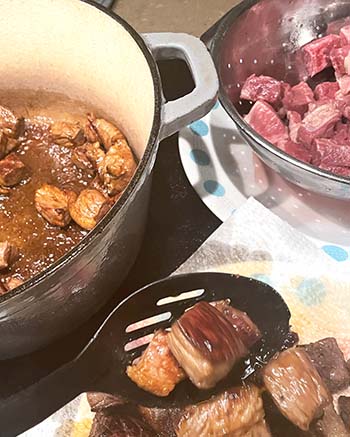
Adding too much raw meat to the pan at once will bring the temperature of the pan down and draw moisture out of the meat. This will cause it to boil or steam rather than brown.
Instead, add the meat to the pan in small batches, a few pieces at a time and allow it to heat up a bit before adding more. Keep space between the pieces of meat in the pan.
If you are browning a lot of meat then work in batches. Move the browned meat to a plate and add a little more to the pan. Put it all back in at the end to reheat.
If you see water bubbles around the meat and notice that it’s turning greyish rather than a nice brown, take all the meat out, dry the pan and the meat and start over.
Testing for
Doneness
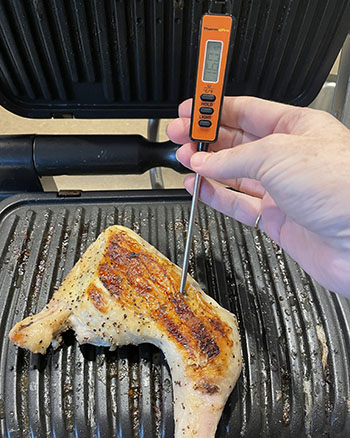
Always use a meat thermometer for dry heat cooking methods.
If you watch TV chefs or read recipes, they may say things like:
“Your steak is done if it feels like the pad of your thumb” or “cook until the juices run clear.”
These are good guides but there is nothing like the precision of knowing for sure.
If you’ve ever had food poisoning, I guarantee it’s an experience you don’t want to repeat. Yet, you don’t want to overcook your meat either.
So, use a thermometer to test your meat.
Doneness Chart
|
Rare |
52°C to 54°C 125°F to 130°F |
|
Medium |
60°C to 66°C 140°F to 150°F |
|
Well Done |
71°C to 82°C 160°F to 180°F |
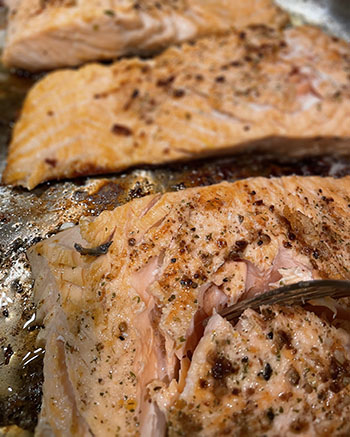 Testing Salmon with a Fork
Testing Salmon with a Fork- Beef can be cooked to preference, rare medium or well done.
Medium-rare is recommended for best flavor and juiciness. - Ground meat must always be well done.
- Pork can be slightly pink or well done.
Many people are nervous about any pink at all in pork for fear of trichinosis, but trichinosis from pork raised under modern conditions with proper inspection is very rare2. - Lamb can be slightly pink, medium-well.
- Chicken must be well done to prevent salmonella.
- Fish is the exception to the thermometer rule. Pierce it with a fork and twist slightly. The flakes should come apart but still be moist. If it’s not done it will be kind of jelly like.
Roasting or Baking
Meat
Roasting and baking are done in an oven where the food is surrounded by ambient heat. They are really the same thing though baking usually refers to smaller thinner cuts like fish, chicken cutlets or pork chops. Roasting suggests a large piece of meat like a prime rib roast or a whole bird.
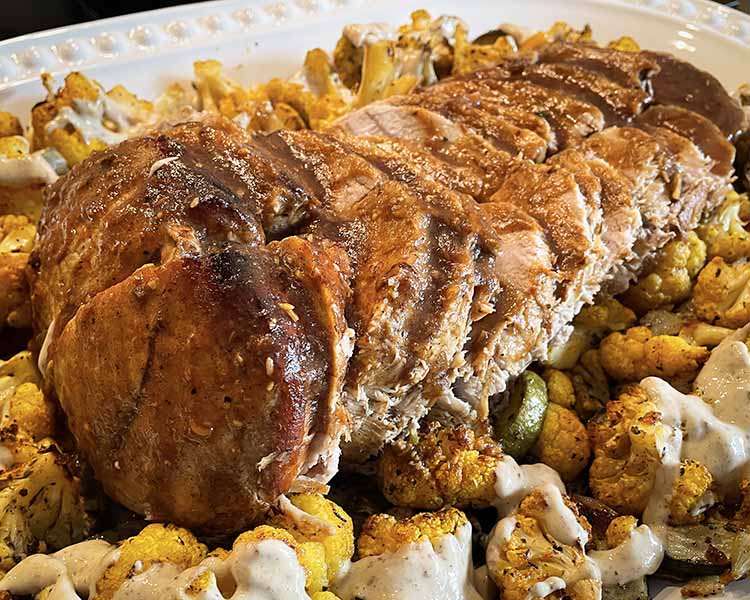 Gluten-Free Pork Loin Roast
Gluten-Free Pork Loin RoastOven Temperature
If you look up recipes for any roasted meat whether it's chicken, beef, pork or lamb, you'll see a variety of cooking temperatures recommended. This reflects the cooks preference. Just remember, a hot oven will brown the outside. Slightly cooler will give you less shrinkage and more even doneness. You can change the oven temperature part way through cooking to take advantage of both.
I like to start a beef roast or a turkey in a very hot 450°F oven for about 15 minutes so the outside gets nicely browned, then turn it down to 375°F and the inside can be cooked to a nice medium rare for beef. If you prefer medium well to well done which is necessary for turkey, then slow it down a bit and cook at 350°. You’ll get a more even doneness from outside to inside.
Roast chicken works well at 375°F. You get a nice crispy skin and you can still cook the chicken to well done without drying it out.
You can also brown your roast on top of the stove before putting it in the oven.
Smaller pieces of meat like boneless chicken breasts or fish are best cooked quickly at a higher temperature. 400° to 425° works well. I’ve even seen recipes that suggest baking chicken breasts at 450°.
Preparing Your Meat
Dry and Season
Start with good quality cut of meat. Dry off the surface, brush with oil and season with salt and pepper. Add other spices if you like just be sure they are gluten-free.
Fat in Cooking
Fat has been demonized in our culture, but I think this is misguided, and there is lots of science to back this up.3
Fat is necessary for browning and browning enhances the color and flavor of your meat. It also keeps the meat moist and tender.
If you have a roast with a nice fat cap on it, you’re all set. Score it in two directions with a knife and roast the meat with the fat on top so it runs down into the meat while it’s cooking.
If the fat has been trimmed off, then you’ll need to add your own.
Bacon fat or lard adds nice flavor to a roast. Cooking oil works well for whole chicken or smaller pieces of meat. Expensive oil is not necessary.
Choosing the right fat for gluten-free meat cooking is nothing special. All pure fats and oils are naturally gluten-free. Of course always read labels but there should be no cause for concern here.
Resting Your Meat
A lot of people skip this step but it's so important.
When your meat is subjected to heat, it forces the juices out of the tissues into the surrounding spaces. That's why when you pierce your meat when it's still on the grill or fresh out of the oven, juices run out quickly.
Letting your meat rest for a few minutes will allow the juices to soak back into the fibers and your piece of meat will remain plump and moist. Cut it too quickly and it will be dry and tough.
Simply remove your meat from the heat to a warm platter. Tent with foil to keep it warm and let it rest while you finish your sauce or sides.
|
Steak Roast Chicken breast Roast Chicken |
5 to 8 minutes At least 15 minutes 8 to 10 minutes At least 15 minutes |
Roasting
Meat
Your oven is hot. Your meat is prepared. Now put it in a baking dish or roast pan that fits snugly but leaves enough room for air to circulate. A rack keeps the meat off the bottom of the dish. Place the roast in the oven and set the timer.
Timing Your Roast
Temperature will be the final decider as to whether your roast is done. But these timings will give you a guideline so you know when to check.
Your meat should be thawed and at room temperature when it goes in the oven. If it is still a bit frozen in the middle it will take longer.
|
Beef, Pork, Lamb or Veal |
Per Pound |
|
Rare Medium Well Done |
15 minutes 20 minutes 25 minutes |
|
Chicken, Turkey or Duck | |
|
Well Done |
20 to 25 minutes |
Baking Smaller
Pieces of Meat
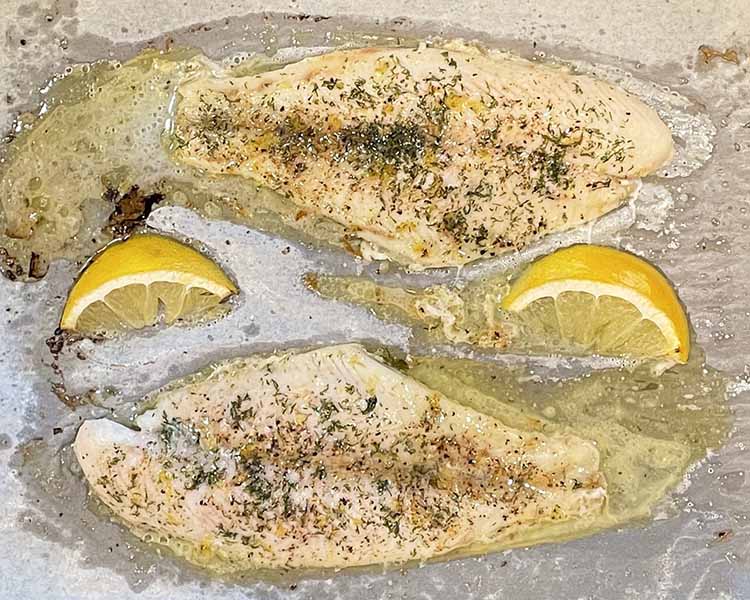 Baked Basa Filets with Lemon Wedges
Baked Basa Filets with Lemon WedgesBoneless chicken breasts or fish filets are done pretty much the same way.
Once the oven is hot and the meat is prepared, lay it out on a parchment lined baking tray. Bake until your meat reaches the desired temperature. Remember to use your thermometer and refer to the chart above.
A thin filet will take 10 – 12 minutes. A chicken breast will be more like 20 – 25 minutes.
Broiling or Grilling
These terms are often used interchangeably. We usually think of grilling as being done on an outdoor grill, a barbecue or on an indoor grill. Broiling is often thought of as cooking under the broiler setting in the oven.
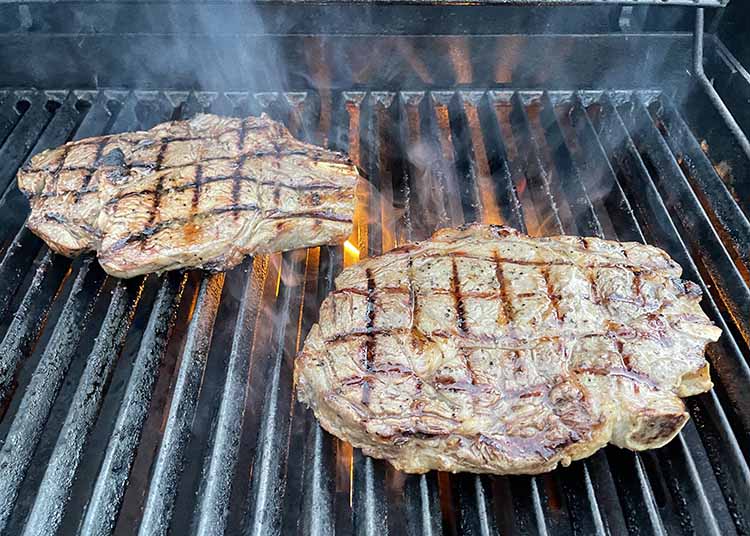
Either way its high heat applied to the surface of the meat. I tend to shy away from broiling in the oven because I don't really enjoy cleaning my oven that much.
This technique is best for thin cuts of meat like steak, pork chops, boneless chicken breasts or fish filets.
The steps are:
- Preheat the grill.
- Prepare the meat with oil and seasoning.
- Place on the grill or under the broiler.
- Use your thermometer to test for doneness
Timing on the Grill
Temperature will determine doneness but these timings will give you a guide.
|
Steak or Chops* |
Time Per Side |
|
Medium-rare Medium Well done |
3 to 5 minutes 5 to 7 minutes 8 to 10 minutes |
|
Chicken Breast | |
|
Well done |
5 to 7 minutes |
|
Salmon Filet | |
|
Medium |
6 to 8 minutes |
*Pork should be cooked to medium-well or well done. A little pink is okay.
Chicken must be well done
Salmon can be medium-rare to well done. Don't overcook, it will dry out quickly.
Pan Frying
This method involves cooking in a bit of fat on top of the stove. You might pan fry a steak, pork chop, sausages, bacon, chicken breast, or a fish filet.
Heat the oil over medium high heat and place your pieces of meat in the pan “presentation side down”. This simply means that the side which will be face up on the plate should start face down in the pan. This is because the first side cooked lies flat in the pan and will look nicer once it’s flipped over and presented on the plate.
Pro tip, let the meat cook for a minute before trying to move it. The cooking will allow the fibers to loosen from the pan. It can then be moved to prevent sticking.
Remember not to overload your pan or your meat will not brown.
Finishing in the Oven
The problem with pan frying is that thicker pieces of meat won’t cook through before the outside becomes over cooked. In this case, many cooks will finish cooking in the oven.
Stir-Frying
Stir-frying is the perfect way to get a quick meal on the table while cleaning out the fridge of leftover bits of meat and vegetables. It's my "no waste" dish.
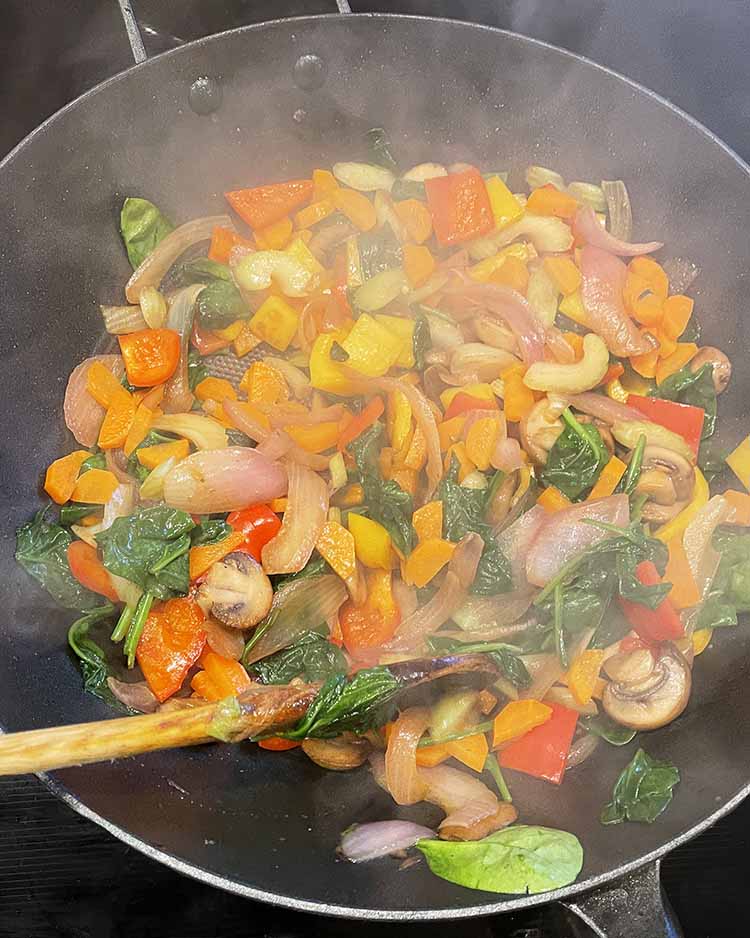
Stir-frying is also done on top of the stove in a bit of oil. The difference is that it’s done with smaller pieces of meat, usually diced into 1” (give or take) cubes. The term “stir frying” means to keep the meat moving in the pan. This promotes even cooking and prevents burning.
Work in small batches to avoid overloading the pan, removing your meat to a plate with a paper towel as you go.
Stir-fries often contain vegetables as well as meat. Cook the meat first and remove it from the pan. Then add the veggies, one type at a time starting with the one that takes the longest to cook.
Most stir-fry pans have ridges on the side so that the partly cooked food can be moved up the side of the pan and the new item added into the hot oil on the bottom. Add more oil as needed.
Once the veggies are almost cooked, add the meat back into the pan. If liquid is to be added, do it now. A simple glaze is nice on a stir fry. Add a bit of gluten-free soya sauce, a little honey, a squirt of lemon juice then thicken it up with a bit of corn starch or tapioca starch and water.
Moist Heat
Cooking
The second type of cooking for meat is moist heat cooking. It involves cooking with a liquid like water, stock, wine, juice or milk. Meat cooked in liquid does not brown.
Make sure the liquid you choose is gluten-free. Many commercially produced beef and chicken stocks contain gluten.
Since you’re using cheaper cuts of meat, mastering moist heat cooking can be a great way to save money and still have lovely tender and delicious meat dishes.
Boiling
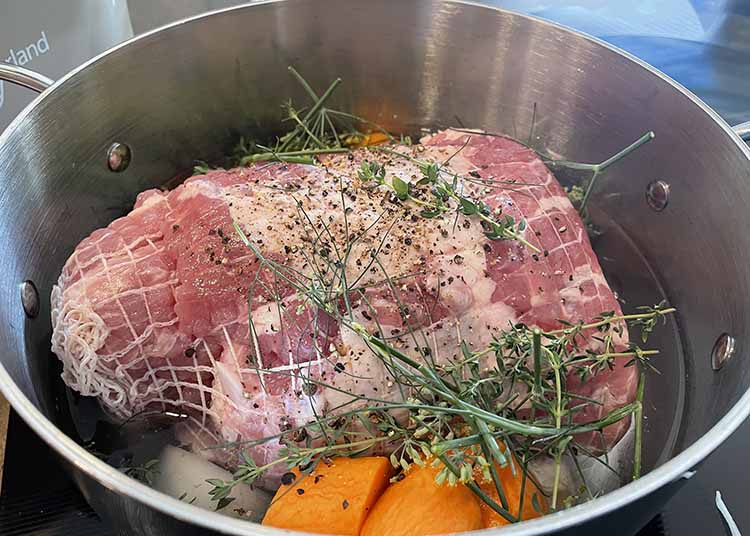 Pork Cottage Roll with Herbs
Pork Cottage Roll with HerbsIf you mention boiled meat, many people will turn up their noses. Yet boiled beef is traditional in many cultures from France and Italy and through many African and Asian countries. Boiling or simmering meat is a way to tenderize tougher cuts of meat so was in the past considered “low brow”. Now, many cooks recognize the depth of flavor in these cheaper cuts of meat and how that flavor can be imparted to the liquid it’s cooked in to make a wonderful soup or sauce.
Meat that is boiled is often seasoned and brined for several days to add flavor. It can then be boiled in water or stock that is flavored with onions, carrots, herbs and spices.
If you're buying a product that has been brined or marinated, make sure all the ingredients are gluten-free.
Poaching
Poaching involves cooking in a small amount of liquid at a gentle simmer.
This is the exception to the "cheaper cuts" rule for moist heat methods. Poaching is quick and it’s most common for delicate cuts like fish. Chicken and veal can also be poached. Poaching beef and pork is less common.
Liquids commonly used for poaching are water, stock, juice or milk. Check labels to ensure the liquid you choose is gluten-free.
Testing for Doneness
For moist heat, when you're using those wonderful, flavorful, tougher cuts, bringing the meat up to the correct temperature isn’t enough. You need the extra time to break down those tough fibers and tenderize the meat. So, doneness is about tenderness not temperature.
To test a pot roast, stick your big meat fork into the center. If it goes in and comes back out easily, its done. To test a stew, just take a piece out and taste it. If it’s tender, then it’s done.
For poaching, use the same methods to test for doneness that you would for dry heat cooking. A meat thermometer, your fork for fish or open up a piece to see what it looks like inside.
Combination Dry and Moist Heat – Braising
It’s easy to fawn over a perfectly cooked steak or the holiday bird that takes center stage. But a hearty, delicious slow cooked beef bourguignon or the lowly pot roast to me just melts the tongue, fills the senses and makes you feel like you’re wrapped in a warm blanket.
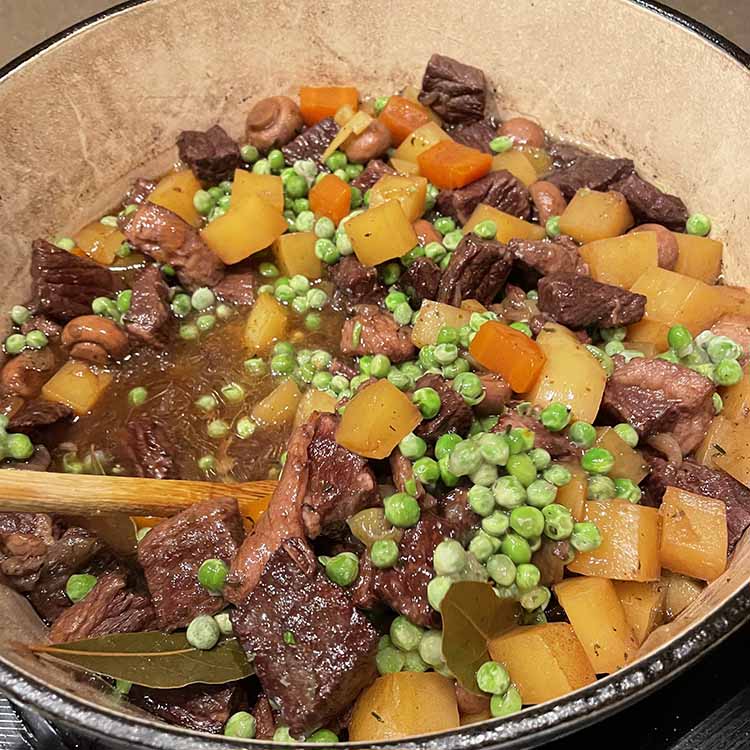 Gluten-Free Beef Stew
Gluten-Free Beef StewBraising
uses both moist and dry heat cooking and is my personal favorite method of cooking meat.
You get the flavor and aromatic benefits of the Maillard reaction and the silky robust depth of flavor from braking down that collagen fiber over a long slow simmer.
The cuts of meat you would choose are the same as for moist heat cooking. It’s those less expensive, tougher cuts that benefit from gentle heat and long cooking times.
Start Dry - Browning Your Meat
Start with a bit of oil in a pan or Dutch oven. It’s just like pan frying or stir frying. Add the meat in batches. Don't overload your pan. If you're doing a roast just keep it turning so it's evenly brown on all side.
Add Your Liquid
This is usually stock or a combination of stock and wine. It can also include juices and water. The liquid you choose will depend on the cut of meat and the end result you're looking for. It may also depend on the cultural origins of the dish you're making.
For beef you need strong flavors like beef stock and red wine.
Chicken and pork are lighter in color and more delicate. You'll likely choose chicken stock and white wine.
Pork is enhanced with some sweetness or citrus so you might consider adding a bit of orange juice or apple juice.
Testing for Doneness
Testing for doneness is also the same as for moist heat cooking. It’s about tenderness not temperature.
Stew vs Pot Roast
A stew is diced meat, about 1 ½ - 2” cubes, seasoned, browned, covered with liquid, toped off with additional herbs and aromatics, then simmered either in the oven or on top of the stove until the meat is fall apart tender.
A pot roast is the same process but with a large piece of meat. You might use beef chuck or pork shoulder. Brown the roast in a bit of oil then add your liquid about 2/3 up the roast. Herbs and aromatics go in next, then simmer long and slow in the oven or on top of the stove.
Gluten-Free Meat Recipes
Sources:
1. Gavin, J. (2020, March 30). Maillard reaction: The key to flavor development. Jessica Gavin. Retrieved October 13, 2022, from https://www.jessicagavin.com/maillard-reaction/#:~:text=The%20Maillard%20reaction%20is%20a,aromas%2C%20and%20appearance%20of%20food.
2. Government of Canada, C. F. I. A. (2013, March 11). Government of Canada. Canadian Food Inspection Agency. Retrieved October 13, 2022, from https://inspection.canada.ca/animal-health/terrestrial-animals/diseases/reportable/trichinellosis/fact-sheet/eng/1330023015817/1330023110684
3. The truth about fats: The good, the bad, and the in-between. Harvard Health. (2022, April 12). Retrieved October 13, 2022, from https://www.health.harvard.edu/staying-healthy/the-truth-about-fats-bad-and-good
